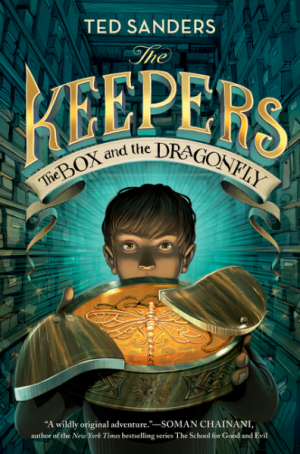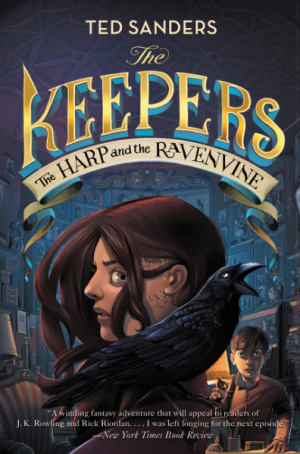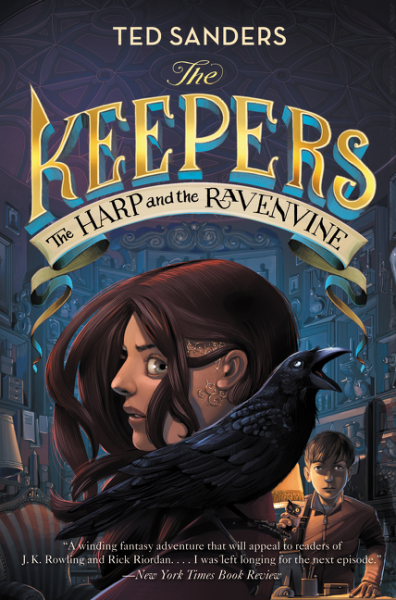Talking about the “scientific method” is a pretty good way to get a middle schooler’s eyes to glaze over. But science is magic, or at least the magic works like science, in The Keepers, a fantasy series for middle-grade readers by Urbana author Ted Sanders. Over the two books of the series published to date, the young heroes use scientific techniques to explore a new, magical world.
 In The Box and the Dragonfly, the first book in the series, we meet Horace Andrews and Chloe Oliver, two 12-year-olds who become Keepers. Each of them is bonded to a magical object known as a Tan’ji. Horace, Chloe, and the other Keepers use the powers of their Tan’ji to do battle against the Riven, as part of a centuries-long war over control of magic. (You can read more about The Keepers in Mathew Green’s interview with Ted and review of The Box and the Dragonfly.)
In The Box and the Dragonfly, the first book in the series, we meet Horace Andrews and Chloe Oliver, two 12-year-olds who become Keepers. Each of them is bonded to a magical object known as a Tan’ji. Horace, Chloe, and the other Keepers use the powers of their Tan’ji to do battle against the Riven, as part of a centuries-long war over control of magic. (You can read more about The Keepers in Mathew Green’s interview with Ted and review of The Box and the Dragonfly.)
Magical artifacts and epic secret wars are all par for the course, at least in the world of fantasy series for younger readers. But in most fantasy series, magic is erratic and fickle. It rarely stands up to the scientific idea of “replicability”, which means that an experiment should give the same results over multiple trials in order to be considered valid.
In its simplest form, the scientific method means observing, testing, exploring, theorizing, and verifying. For instance, Galileo theorized that two objects of different masses would fall at the same rate. In repeated tests over centuries, that theory has held up.
As Horace and Chloe learn about their Tan’ji, the devices seem less like magic wands and more like scientific instruments. Over the course of the books, Horace and Chloe make repeated tests to understand the full scope of their abilities. Each Tan’ji has a specific purpose, but a wide range of potential applications that can only be deduced through experiments.
I interviewed Ted to learn more about the role science plays in The Keepers. We talked about demonstrating science to school audiences, designing a magical world that operates by clear rules, and inspiring a love of experimentation in young readers.
In The Box and the Dragonfly, Horace Andrews receives his Tan’ji, the Fel’Daera. It looks like an ornate box, with a lid the slides shut. Horace realizes that whatever he puts inside the box disappears, only to reappear a day later. When he looks into the box, Horace finds that he can see one day into the future.
Smile Politely: How did you set about making your characters driven to investigate and explore?
Ted Sanders: There’s a lot of emphasis on how curious Horace is. He’s ordinarily kind of cautious, and maybe even timid, but he’s got this driving curiosity. He does need to know what’s going on.
That scene, with the investigation of the Fel’Daera, that became the chapter “Night Experiments” [in The Box and the Dragonfly], was originally much longer. Horace was being even more methodical and cautious. It took him longer than one night to figure out exactly what was going on.
I won’t go into too much detail, but he originally did a lot more thinking about it. Like, well, does the air in the box disappear? Where do the molecules actually go? He puts smoke in the box, and water.
Long before I ever thought about even writing a kids book, I had that idea for the box. Once I started to really think about how it would actually work I kind of got into the mindset of here’s what I would try, what I would wonder. I could have written two hundred pages of just that, but it’s long enough as it is.
I had this whole thing, and it may still happen, where he ties a toy soldier to a piece of string and then puts that in the box and closes the lid. He’s not sure it’s going to work, because he’s not sure the lid’s going to seal, but it does. And then the next day it’s dangling there from a string that goes nowhere, and he wonders, “What if I pull on this?”
SP: What inspired you to give magic in The Keepers a scientific framework?
TS: I used to work at a kid’s bookstore here in town, and I read a lot of kids books. I read Harry Potter, and I was always frustrated because of the magic. The magic seemed really cool, but it also seemed like carte blanche to do whatever you wanted. Like if you wanted something, you just had to will it to be so. And how does that actually work? Where does the magic come from? Why can some people do it and some not?
So I was interested in trying to figure out something where you’d actually have to think about how the magic works. I didn’t want to write science fiction, but one of the defining quotes for the book is Arthur C. Clarke’s third law: “Any sufficiently advanced technology is indistinguishable from magic.”Fantasy so often takes for granted how its magic works. I know if I were in a magical world I would ask “How is that happening?” Because I’m that way in the regular world. Like, “How do they make that road, or how do they build that building?” It’s the same way for me in the fantasy world. I’m more like Horace that way.
 ———
———
The Harp and the Ravenvine introduces April, a new Keeper, whose world is blown wide open when she discovers that she has gained the ability to sense the minds of animals. She uses that power to read into the thoughts and emotions of her her family dog and her pet raven, Arthur, who can helpfully spot approaching danger, as well as shiny objects.
———
SP: What does April learn about thought and cognition from exploring animal minds?
TS: That was kind of a challenge, because I am truly an evolution nut. It was really important to me that nothing magical, in the capital “M” sense, would happen with the animals; I really wanted them to be animals. I remember I had a lot of arguments with my editor, well not “arguments”, conversations with my editor. She asked, “When will April be able to actually talk with the animals, and have a conversation?”
And that doesn’t make sense. There are things animals can understand and can communicate. But they don’t really have a sense of symbolic language, in most cases. The world is way beyond them in a lot of ways. That was a big thing for me.
I think April intuited that already. Because she already loved animals, she thinks of them as animals. It’s sort of paradoxical, but I think when you realize the limits of what an animal mind actually can do, or, in other words, when you don’t anthropomorphize what an animal mind can do, then you can actually enjoy the wonder of what their minds and their senses actually can do.
I did a lot of research on ravens to figure out Arthur. I knew April had a companion, and I knew ravens were super smart animals. They can do all these different vocalizations. One of the cool thing about ravens is that as in the book when Arthur talks and imitates voices, ravens can really do that. They’re like parrots and will imitate voices or singing. That was a little bonus thing for me, that [Arthur] actually can talk, well, parrot. [Arthur and April] are not going have a conversation, but he can parrot.
[The dog] was kind of a late realization. I know dogs have great hearing, and I know they have great smell. When I researched it a little bit, I read how much of their brain is dedicated to smell.
The cool thing that April comes to realize later on, is that dogs’ sense of smell — because it is so keen — becomes a time machine. Their noses are so sensitive that they can tell that the smell is lightly fainter over here and slightly stronger over here, a difference of a human passing over the course of two seconds. That’s enough of a difference in the intensity of the smell for them to know which way that person went. It’s crazy.
This whole notion that smell opens up this fourth dimension of time was a total revelation to me. Because we have nothing like that. Sounds come and go instantly but smells linger. You can tell when someone was here, how long that body has been decaying, all that kind of stuff.
SP: How do you think The Keepers can inspire future generations of scientists?
TS: When I go on tour, one of the big things I do when I meet with kids is I teach them about the scientific method. I don’t tell them that’s what I’m teaching them. We sort of revisit that scene with Horace, the “Night Experiments” chapter.
I have a mockup of the box, with a little hole in it. I have a video where I put the key inside the box, and then open the box and the key is gone. And the kids are like, woah… And I’m like, okay let’s think about it. We do the whole thing.
First, you notice that the key is gone. Then you ask the obvious question, where did it go? Then you make a guess as to what the answer is. They always guess it’s some kind of video trick or there’s some kind of secret compartment in the box. So then how would we test that? And they say, well you could do it again right now. Then I whip out the box, and I’m like, let’s do it again right now.
A lot of kids think it’s a hole in the box, but the majority think it’s some kinda techno-video trick. Then I just pick the box up, and the key falls out. So then we talk about that, the process. You notice something, you ask a question about it, you guess at an answer, and then you test your guess. That’s the scientific method.
And then you can feel the air go out of the room when I say that. When you start throwing big words out and they’re like, oh he’s talking about science. He’s educating us right now.
But then I back off, and I say, there’s another word for that. It’s just being alive. I say, you guys have been using the scientific method since you were babies. And they’re like “Wha…??” That’s what babies do, right? They crawl around, they notice something on the floor, they ask themselves “Can I eat that?” And they decide, “Yeah I probably can”. And then they test it out by putting it in their mouths. That’s the scientific method right there.
To me that’s really a lot of what the series is about, is trying to get them to realize that science is magical, and it’s not unreachable. It’s an easy thing to do in a lot of cases. We don’t often ask kids to try to figure it out on their own, to be curious and say “Well I wonder what that is there.” To actually realize that experimenting doesn’t need to be super fancy. You can just go and check it out, you can see what happens if you do that.
Like have you ever seen the candle trick? You take a candle and light it and let it burn for a little bit, and then blow it out. With the smoke trail, you can actually relight the candle via the smoke. You can really do this. You need a candle in a still room, and then just get the lighter in the smoke, and it’ll relight. I show videos, at regular speed, and students ask what’s happening. They figure it out pretty quickly, “oh I think it’s the smoke.” And I say, it is, or that’s a pretty good guess, but let’s slow it down. I show them the slow-motion videos where you can actually see the smoke ignite. It’s like a gaseous fuse.
It’s really cool, especially in the dark. I do it for them live, and I say, you can do this at home. Don’t burn anything down, you know, but this is nothing fancy. You can do it.
Then they start to wonder, “how come it works sometimes and not others? How come the smoke burns down and not up?”
It’s just getting kids to be curious, and to not just settle for an answer. Or what I think is worse: settling for just not knowing, like it isn’t worth the effort to know. So I’m trying to get them to think, no it really is worth knowing. Because it’s much cooler to discover something than to be told it.
The more I can have discovery in the books, and the kids can share in the joy of discovery that the characters are having, then the more I hope they can be like that in actual life. I wish everybody were more like that. I’m always stunned by how uncurious a lot of people tend to be. I’m a big advocate of being curious about the world, and trying to find what the answers are.
About Nathaniel Forsythe…
Nathaniel Forsythe is a writer living in Champaign. At the age of 11, he blew two fuses and left burn marks on the carpet as part of an “experiment”.








